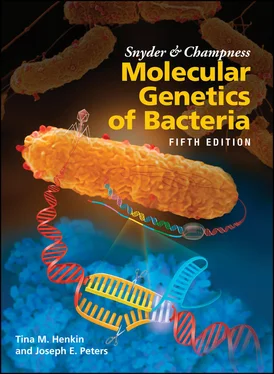The targeting factors recognize proteins to be transported into or through the inner membrane and help target them to the membrane. Which type of signal sequence a protein has determines which of the targeting factors directs it to the SecYEG translocon. Enteric bacteria like E. coli have at least two separate systems that target proteins to and through the membranes. The SecBsystem is dedicated to proteins that are directed through the inner membrane into the periplasm or exported from the cell. The signal recognition particle (SRP) systemseems to be dedicated to proteins that are mostly destined to reside in the inner membrane. Another protein, SecA, participates in both pathways, at least for some proteins; it is found in all bacteria, but not in archaea or eukaryotes, although in eukaryotes other proteins may play a similar role.
Proteins that have a removable signal sequence and are transported through the inner membrane into the periplasm or beyond are most often targeted by the SecB system in E. coli and the other bacteria that have it. The SecB protein is a specialized chaperone that binds to presecretory proteins either cotranslationally (e.g., as soon as the N-terminal region of the polypeptide emerges from the ribosome) or after they are completely synthesized, thereby preventing them from folding prematurely and ensuring that the signal sequence is exposed. The SecB chaperone passes the unfolded protein to SecA, which facilitates the association of the protein with the SecYEG channel, perhaps by binding simultaneously to the signal sequence and to a SecYEG heterotrimer ( Figure 2.38B). Some bacteria have paralogs of SecA that may be dedicated to transporting only one or very few proteins. After SecA binds to the channel, the cleavage of ATP to ADP on SecA provides the energy to drive the protein into the channel, aided by the proton motive force of the membrane. As the protein passes through the channel, it loses its signal sequence, as shown in the figure. SecB is not an essential protein, and the cell can use DnaK or other general chaperones as substitutes for SecB to help transport some proteins.
The SRP pathway in bacteria generally targets proteins that are to remain in the inner membrane. It consists of a particle (the SRP) made up of both a small 4.5S RNA, encoded by the ffs gene, and at least one protein, Ffh, as well as a specific receptor on the membrane, called FtsY in E. coli , to which the SRP binds. FtsY is sometimes referred to as the docking protein because it “docks” proteins targeted by the SRP pathway to the SecYEG channel in the membrane. The ftsY (filament temperature-sensitive Y) gene was originally identified through temperature-sensitive mutations that cause E. coli not to divide properly and to form long filaments of many cells linked end to end at higher temperatures, but its role in cell division is indirect.
Figure 2.38Cillustrates how the SRP system works. The SRP binds to the first hydrophobic transmembrane sequence of an inner membrane protein as this region of the protein emerges from the ribosome. The complex binds to the membrane, and synthesis of the protein continues, feeding the protein directly into the SecYEG translocon as the protein emerges from the ribosome. The energy of translation due to cleavage of GTP to GDP drives the polypeptide out of the ribosome into the SecYEG translocon, replacing the role of SecA, although the SecA protein might still be required for transmembrane proteins with long periplasmic domains.
The process of translating a protein as it is inserted into the translocon is called cotranslational translocation. There is a good reason why proteins destined for the inner membrane are cotranslated with their insertion into the translocon in the membrane while proteins targeted by the SecB pathway can first be translated in their entirety and then inserted into the translocon. Inner membrane proteins are much more hydrophobic than exported proteins and would form an insoluble aggregate in the aqueous cytoplasm if they were translated in their entirety before being transported into the membrane (see Lee and Bernstein, Suggested Reading).
What happens after an inner membrane protein enters the SecYEG channel is less clear. The transmembrane domains of the protein must escape the SecYEG channel and enter the surrounding membrane, while the periplasmic and cytoplasmic domains must stay in the correct compartments. Presumably, the SecYEG channel has a lateral gate that opens and allows the transmembrane domains of the protein to escape into the membrane. Another inner membrane protein called YidC might help in this process ( Figure 2.38C) (see Xie and Dalbey, Suggested Reading). YidC seems to be required for the lateral escape of some proteins but not others. Some inner membrane proteins bypass SecYEG altogether and require only YidC to enter the inner membrane.
Sec Systems of Archaea and Eukaryotes
Archaea and eukaryotes do not have SecB or SecA and use the SRP system to translocate all exported proteins. Although they lack SecA, they may have other systems that help direct already translated proteins to the translocon. The translocon itself was first discovered in eukaryotes and is composed of three proteins that form similar structures in all three kingdoms of life. The amino acid sequences of the SecY and SecE subunits are similar in all three kingdoms; only the sequence of the third subunit (SecG in bacteria) is very different in eukaryotes and archaea, where it may have different functions. While eukaryotes have other such channels, the translocase, which helps transported proteins to enter the endoplasmic reticulum of eukaryotic cells, is the one most similar to the SecYEG channel of bacteria.
The SRP system was also first described in eukaryotes, where it is much larger, consisting of a 300-nucleotide RNA and eight proteins, six in the SRP and two in the docking protein, called the SRP receptor. However, some of the proteins in eukaryotes are very similar to those in bacteria, such as the 54-kDa SRP protein in eukaryotes, which is similar to the Ffh protein in the SRP of bacteria. The SRP system of eukaryotes targets both membrane and presecretory proteins to the endoplasmic reticulum.
The Tat Secretion Pathway
Only proteins that have not yet folded and so are still long, flexible polypeptides can be transported by the narrow SecYEG channel. Once folded into their final three-dimensional structure, proteins are much too wide to fit through the channel. However, some proteins must fold in the cytoplasm before they can be transported. These include membrane proteins that contain redox factors, such as molybdopterin and FeS clusters, which are synthesized in the cytoplasm and can be inserted into the protein only after it has been folded. Other examples of proteins that are transported after they are folded are some heterodimers in which only one member has a signal sequence, so the other partner would be left behind if the signal sequencecontaining polypeptide is transported before the two polypeptides have combined and folded. Folded proteins and complexes are transported by the Tat system.
STRUCTURE OF THE TAT SYSTEM
The Tat system of E. coli has three subunits, TatA, TatB, and TatC, while that of B. subtilis has only two, with TatA and TatB seemingly combined into one larger subunit. In E. coli , TatB and TatC bind the signal peptide on the protein to be transported and then recruit TatA, which forms the channel in the membranes. In this way, the channel may form only when there is a protein to be transported. Unlike the Sec translocon, which uses both the energy of ATP cleavage by SecA and the proton motor force to drive the protein through the channel, the Tat system may use only the latter.
Читать дальше











